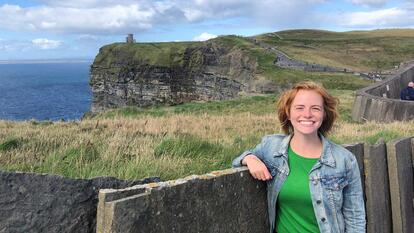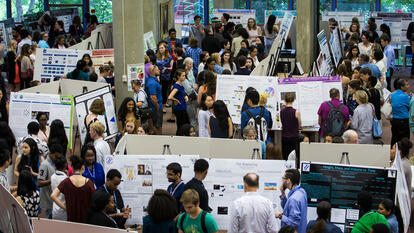Interdisciplinary Research Team Explores Water System on Science Hill

Amid the ongoing construction of the Science Center, Wellesley faculty and staff are using the landscape for a new academic collaboration—Wellesley’s Water Challenge.
The focus of the challenge is to provide students with “experiential, problem-based learning opportunities that can have real impact on management of water resources and biodiversity on campus,” said Kristina Jones, director of the Wellesley College Botanic Gardens and adjunct assistant professor of biological sciences.
Wellesley’s fresh water supply is a critical sustainability issue, particularly since it is drawn from underground aquifers near the Science Center. Activities on campus can affect water quality and quantity. Work on the Science Center prompted Jones and other faculty and staff members to explore current conditions and potential interventions to improve the water system’s sustainability, with the help of students.
The Wellesley Water Challenge involves biology, chemistry, engineering, geosciences, and physics, and it draws on the expertise of every researcher. Six students participated in the collaboration during the summer research projects and additional students participated in research during the school year.
Paramecium Pond and also the Silver Thread, which is a small brook that winds through the Alexandra Botanic Garden and empties into the pond, have been the scene of much of the activity so far.
During the challenge’s summer phase, teams of students working with faculty from various disciplines explored alternative water management schemes for the pond and brook, taking into account the ecology and chemistry of the water system.
In a second phase of the project, a faculty-student team designed a water wheel to extract electricity at the source of the brook, said Amy Banzaert, lecturer in engineering and director of engineering studies, one of the five faculty members on the team. For another part of the project, the team explored the habitats within the brook and how they support aquatic biodiversity.
“One goal is to model team-based applied research experiences with both faculty and students, in which no one person is the only go-to expert but all have skills to contribute to the challenge at hand,” said Jones.
As part of their summer research, Rebecca Arango ’21, Louisa Crane ’19, Nallely Esparza ’21, Kim Hernandez ’21, Thea Louis ’20, and Faisa Warsame ’21 collected samples of sediment deposits and took them back to their laboratory for analysis.
“I believe a lot can be learned from collaboration, and that coming up with creative solutions hinges on bridging gaps and taking a holistic, multilens approach,” said Crane, an environmental studies major. “I learned a lot by working with different professors, and even if I didn't completely delve into every area of study, I was exposed to lots of ideas and concepts.”
Louis said she particularly liked that they conducted field research on campus, close to her lab. “Having the opportunity to collect physical samples from a field site so close to the labs was valuable and something I don’t think is common in scientific research,” she said.
The Water Challenge is an ongoing project supported by the Paulson Ecology of Place Initiative.
Photo: Water Challenge students collect a 100cm-deep sediment core from Paramecium Pond to understand rates of sedimentation over past decades into the pond. Here they are dividing the core into segments to bring back to the lab and analyze composition of the sediments. From left to right : Kim Hernandez ’21 (foreground), Louisa Crane ’19, Thea Louis ’20, Faisa Warsame ’21.
Photo (inset): Student researchers at the 2018 science center summer research program poster session. Left to right: Louisa Crane ’19, Thea Louis ’20, Nallely Esparza ’21, Faisa Warsame ’21, Kim Hernandez ’21, Rebecca Arango ’21.



